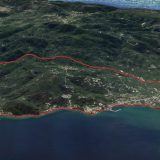Soil Sealing
The soil and its functions
Soil: the upper layer of the Earth’s solid crust, between the geological background and the surface which consists of inorganic and organic matter, water, air and living organisms. Practically non-renewable resource
Local, economic, social and cultural functions:
a) biomass production (eg agriculture and forestry)
b) storage, filtration and conversion of nutrients, substances and water
c) biodiversity stock,e.g. habitats, species of flora and fauna and genes
d) natural and cultural environment for human activities
e) source of raw materials
f) carbon stock
g) legacy of geological and archaeological heritage.
Soil sealing is the permanent covering of part of the earth and the soil with impermeable artificial material, such as asphalt and cement.
Sealing has been identified as one of the key soil degradation processes in the context of the European Commission’s Thematic Strategy on Soil (COM 2006) 231) and the European Environment Agency’s latest report on the state of the environment in Europe (EEA, 2010b). .
It often effects fertile farmland, poses a risk to biodiversity, increases the risk of floods and water scarcity, and contributes to global warming.
Examples of policies, legislation, funding schemes, local planning tools, publicity campaigns and other information campaigns practices applied across the EU.
Europe is the most urbanized continent. 1,000 square meters are removed daily. km (area larger than that of Berlin) for human use, a large percentage of which is eventually sealed. If this trend continues at the same rate, in 100 years it will be converted to an area corresponding to the sum of the territories of France and Spain.
Because soil formation is a very slow process (it takes centuries for one centimeter to accumulate), sealing causes severe damage to the soil and often results in permanent loss. For this very reason, although infrastructure development must be supported to fuel economic growth, more efficient and responsible land management is needed.
Sealing effects – water resources
The soil can store up to 3,750 t / ha of water or almost 400 mm of rainfall. The sealing reduces or eliminates the absorption of rainwater. Therefore:
water reaches the rivers more and faster increased flood risk.
reduced water available to plants increase drought, irrigation and salinization
needs dependence on artificial storage facilities to collect peak precipitation loads is increasing.
In cities with a high degree of soil sealing, the capacity of the sewer system may not be sufficient for high water runoff, resulting in surface floods.
Evapotranspiration
Soil sealing due to urbanization reduces evaporation. In combination with the increased absorption of energy from the sun caused by dark asphalt or cement surfaces,
ceilings and stones, are important contributing factors, along with the heat generated by air conditioning and cooling, as well as the heat generated by produced by road traffic, in the phenomenon of urban thermal island.
Biodiversity
1/4 of the planet’s species live on land. Soil sealing affects biodiversity below and above the soil.
Soil microorganisms play an important role in the decomposition of organic matter in the soil and in the recycling of nutrients. Together with larger organisms, such as earthworms, they can develop the structure of the soil, which now becomes more permeable to water and gases.
Soil provides habitat for subsurface biodiversity and is essential for the survival of most above- ground species. Many species of animals depend on the soil at least at certain stages of their lives – for certain stages of development (many insects), for breeding, nest construction or as a feeding habitat.
Linear sealing of soil (eg roads) interrupts migration routes and affects the habitats of some species.
Sealing effects
Vegetation plays an important role in the capture of airborne particles and in the absorption of pollutant gases. Indirect effects on air quality, because they affect wind speed and turbulence and, consequently, local pollutant concentrations.
Soil sealing breaks the link between the chemical and biological cycles of terrestrial organisms within the soil and prevents soil biodiversity from recycling dead organic matter and the substances and elements from which it is composed.
The reduction / degradation of green spaces and “green corridors” of a city negatively affects the local temperature and humidity (microclimate) and degrades the quality of life. Stamping and urban sprawl can also degrade the landscape, which is of great economic importance (eg for tourism).
Soil sealing can be reduced by clever spatial planning and by halting the spread of cities.
Instead, it is possible to harness the growth potential of urban areas, for example by rehabilitating abandoned industrial areas.
Mitigation measures for the effects of sealing include the use of permeable materials instead of cement or asphalt,
the support of “green infrastructure” and the dissemination of natural water collection systems.
In cases where on-site mitigation measures are insufficient, compensatory measures that enhance territorial functions in other areas may be considered.













